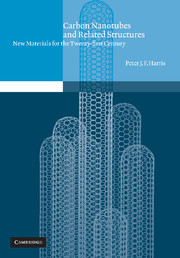Book contents
- Frontmatter
- Contents
- Acknowledgements
- 1 Introduction
- 2 Synthesis: Preparation methods, growth mechanisms and processing techniques
- 3 Structure
- 4 The physics of nanotubes
- 5 Nanocapsules and nanotest-tubes
- 6 The ultimate carbon fibre? The mechanical properties of carbon nanotubes
- 7 Curved crystals, inorganic fullerenes and nanorods
- 8 Carbon onions and spheroidal carbon
- 9 Future directions
- Name index
- Subject index
2 - Synthesis: Preparation methods, growth mechanisms and processing techniques
Published online by Cambridge University Press: 28 January 2010
- Frontmatter
- Contents
- Acknowledgements
- 1 Introduction
- 2 Synthesis: Preparation methods, growth mechanisms and processing techniques
- 3 Structure
- 4 The physics of nanotubes
- 5 Nanocapsules and nanotest-tubes
- 6 The ultimate carbon fibre? The mechanical properties of carbon nanotubes
- 7 Curved crystals, inorganic fullerenes and nanorods
- 8 Carbon onions and spheroidal carbon
- 9 Future directions
- Name index
- Subject index
Summary
… everything, both structure and change, is the outcome of chance
orchestrations of chaos …
P. W. Atkins, The CreationThe formation of beautifully symmetric C60 molecules in the chaotic high-temperature plasma of a carbon arc seems an almost magical process, and it is one which remains poorly understood. A number of models have been put forward, none of which has gained universal acceptance (2.1–2.5). The earliest theory of fullerene formation is the ‘pentagon road model’ put forward by the discoverers of C60 in 1987 (2.1). This assumes that when the cluster size reaches about 30 atoms, graphitic sheets begin to form. As further atoms are added, the formation of pentagonal rings will be favoured in order to minimise dangling bonds, and closure will occur ‘accidentally’, as a result of a fortuitous distribution of pentagons. However, it was realised that this simple model could not account for the high yield of C60 observed experimentally. A more sophisticated version of the ‘pentagon road model’ was therefore introduced (2.2), which stated that a growing carbon sheet will tend to incorporate the maximum possible number of pentagons, consistent with the proviso that the pentagons are isolated. The smallest closed structure which can be formed is then C60. It was also emphasised that efficient production of C60 by the pentagon road mechanism requires sufficient annealing, so that all open clusters would have time to rearrange into the favoured ‘pentagon rule’ structure.
An alternative mechanism, known as the ‘fullerene road model’ was proposed by Jim Heath in 1991 (2.3).
- Type
- Chapter
- Information
- Carbon Nanotubes and Related StructuresNew Materials for the Twenty-first Century, pp. 16 - 60Publisher: Cambridge University PressPrint publication year: 1999
- 5
- Cited by



